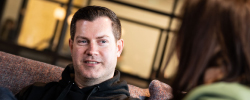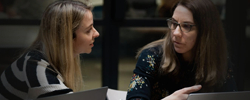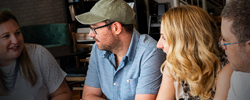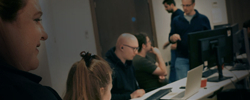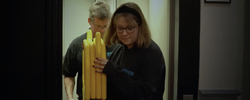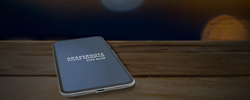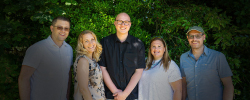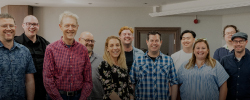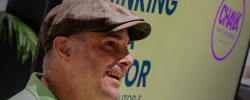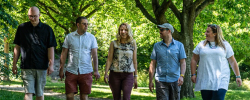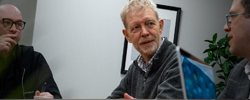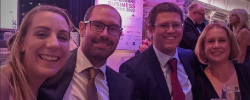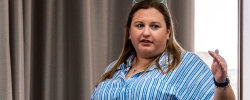We sat down with Joel to find out how Switchplane came about and how it has changed in the last 20 years.
Carrie: So what, or who, is Switchplane?
Joel: “Switchplane exists to bring about meaningful change for the people that we work with. We just happen to use software to do it.
“We build systems for smartphones, for businesses to use on the web, we build portals and websites for customers of the business to make their lives easier.
“Everything about Switchplane is focused on the human, on the individual. My belief is that if you empower the individuals within organisations to do a good job, then the organisation will flourish.”
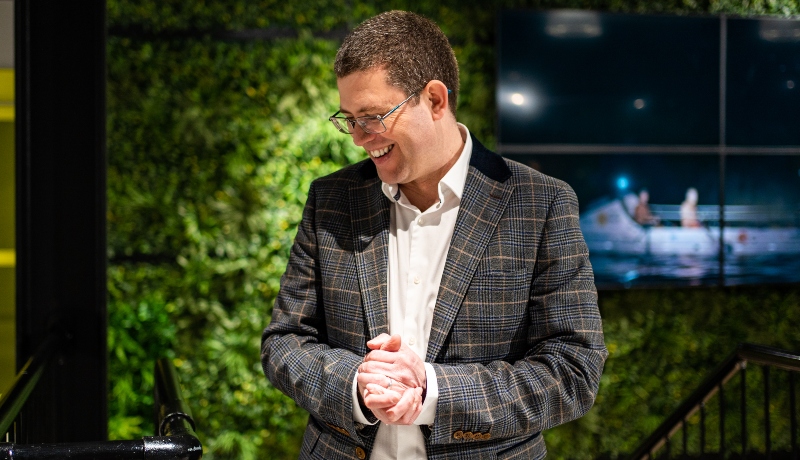
Tell us how it all began…
“I used to love playing computer games; Minesweeper, Cannon Fodder, Lemmings, Rainbow Islands. That’s what got me into computers in the first place. A bit later on, I discovered you could create things on computers, and program them to do different things, that was very exciting.
“When I graduated from university in 2002, there was all the dot com crash chaos and things going on. My particular speciality, which was software engineering and digital signal processing for audio systems, was not being hired for, so it was really out of necessity that we got into web development.
“I moved back home to live with my parents after graduation and Tom was still living at home. It was clear Tom had a similar interest in computers and software. He’d done a Certified Internet Webmaster course, I had a bit of programming experience from doing my placement at university. So we had a basic skillset to get up and running quite quickly. It seemed the obvious thing to do.
“We originally founded the company with four of us, me and Tom and then two other guys called James and Geoff. We still work with James today; he's one of our clients now. We came up with a product idea that was to go after universities and help them with payment capture for their tuition fees. This was around about the time that tuition fees were being rolled out across universities, so there seemed to be an opportunity there. We did a pilot system with the University of Exeter, which was very successful, but ultimately it was discontinued because they went with Oracle. I mean, who’s going to choose tiny Switchplane Ltd over Oracle?!
“So we decided then and there that we were probably not going to stick around in that sector. We needed to try something else. Ultimately we bought out Geoff and James, then continued the process from there.”
What was it like in the early days?
“We were working out of a garage. I was 23 and Tom was 19 or 20. We were basically children and brothers misbehaving! It was quite fun, though we probably didn’t do as much work as we should have done…
“We built a few websites for smaller clients. We got our first, what I would describe as a ‘proper’ big client, in about 2008.
“Victor Kugendra runs a company called British Airport Transfers. That was a big break for us. We went from working with very small businesses for almost nothing, to working with someone who was actually more serious about the direction that he wanted to take his company. It was more of a challenge, so it was more exciting to work on.”

What was the next milestone? Was it taking on a member of staff?
“Taking on staff is always a milestone, especially when you’re small and taking on your first employee when there’s only two of you.
“At the time we were positioning ourselves more of a website design agency rather than software design, which is what we do now. Our first employee was taken on in 2008 as a graphic designer, because I’m rubbish at graphic design and so is Tom - we’re coders, not graphic designers!”
What’s been the biggest challenge as the company has grown over the years?
“Recruitment is very difficult. Finding the right candidate for the job is always a challenge.
“The next challenge is finding clients when they don’t understand what’s possible. You’re having to do two things, sell two products: One, we have to sell the idea that it’s possible to do this thing with your business and achieve transformation; Second, you have to sell us as the people that can do it.”
How proud are you of what you’ve built?
“I am proud of what we’ve done. I think we could have made better decisions along the way, but I’m definitely proud of what we’ve accomplished. We’ve done a lot.
“I’m particularly proud of the team that we have. We’ve got some really good people that work with us, that have been with us for a long time and are loyal to the organisation. I think that does speak for the quality of the organisation, and yes, I am proud of that.”
And what about the work you’ve done?
“Every job is different, and every challenge, although we have seen something similar, brings with it its own twist on what has to be done. So if we’re building, say, an email system for one person, and then another person wants an email system, on the face of it they sound like they’re the same. But actually, when you get into it, the details are not.
“I think that’s something we’re very good at, understanding the differences between how different businesses operate, who their audience is, what needs they have, and then applying that in the systems that we build to make sure that it’s for the situation rather than having a one size fits all approach. It’s something that is unique about our business.”
How do you sort out what the problem is when a client comes to you?
“The conversation goes, ‘yeah, it’s on fire, we’ve got X problem and it’s causing Y amount of chaos. We need some help. We’re desperate’. That’s the first conversation. And then we come in.
“We say, ‘Ok, well, you’re not alone. Most businesses go through this point, especially if they’re growing quickly. Most businesses have that challenge’. It’s just a simple chat to start off with. At the initial chat, we try to get to the bottom of what’s causing the pain, and then we’re able to prescribe some sort of relief for that pain. Normally that’s going to be some kind of software application.
“For instance, if you’ve got a company that’s having to use multiple spreadsheets to keep track of something, that’s a perfect example of how problems can arise in a business. We’re able to take that pain away. It’s a very simple example, but hopefully that explains.”
Can you sum up the Agile process?
“Agile is a bit of a buzzword that’s used by people in the software industry. Fundamentally, the purpose of Agile is to take the risk out of building software.
“For instance, there’s two ways you could approach it. A client could come to us and say, ‘I want you to build this amazing thing’, and then we say, ‘yeah, fine’. And we can build an amazing thing; we go dark for 18 months, working on amazing thing. Then we can present it back to them in 18 months time and we say, ‘hey, we’ve got this amazing thing’. They point at it and say, ‘well, that’s not what we wanted’. At that point you’ve got 18 months worth of work which needs to be chucked away as it’s not fit for purpose.
“The way that Agile works is that instead of going dark for 18 months, we go dark for two weeks instead. And then we present a thing, the next possible increment, the simplest thing that could possibly work in this scenario. And then the client can point and say, ‘I kind of like that, but would it be better if we tried this?’
“The fundamental difference between Agile and the way a traditional product is built is that you can just chuck away two weeks of work if you go down the wrong path, instead of chucking away 18 months of work. That’s the critical difference. You’re turning 18 months of risk into two weeks of risk.”
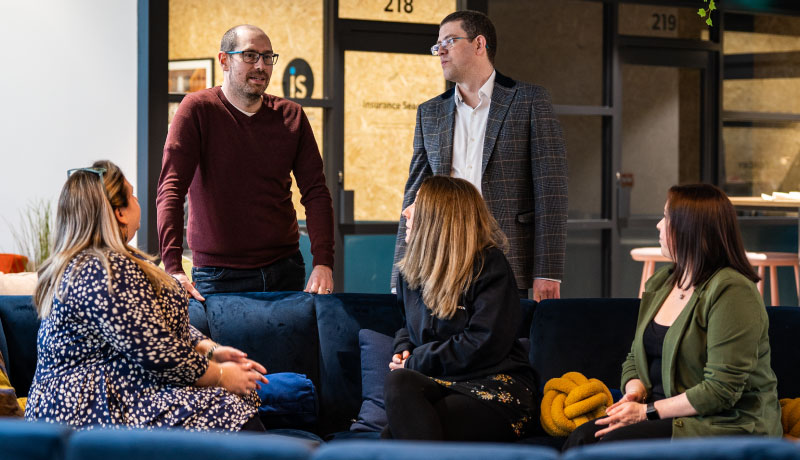
What’s different about Switchplane to other software applications?
“The key difference is the people. Off the shelf is great and it’s the right solution in many cases. But for many businesses, the opportunity to differentiate themselves is through their people. Especially in a regulated industry, such as lawyers, accountants and insurance, where ultimately they all have to do the same job. The only real way of differentiating is through their people. Our focus is on enabling those people to perform to the best of their ability. I think that’s what sets us apart.”
What challenges do you foresee in the future?
“There’s no question that this decade we’re going to see a huge transformation in how businesses work. For instance, artificial intelligence is really big right now. One of the challenges coming up in this decade is how artificial intelligence is going to change business.
“The challenge with AI is how do you incorporate it into a business in a sensible way? That needs people who understand the technology, first of all, to understand what’s possible. But it also needs people that can translate that into recommendations for a business. Someone who can look at the requirements of an organisation and say, ‘ok, hold on, if we do X, then you can apply this technology in this way’. That’s where we come in.
“We sit at the intersection of the business person and the technical person. We help them make sensible decisions about how they can adjust their strategies to take advantage of the latest technology.”
“The future is always going to be exciting because you don’t know what’s going to happen. You’re always in a position where you’ve got to navigate new challenges, and I do find that interesting.
“So I am excited because it means new problems to solve new things, to build new technologies, and new people to work with.”
Would you like to know more about who we are and what we do?
Then get in touch with us for a chat.
hey!
We build custom software with your team, for your team. Our apps and web platforms bring about meaningful change for businesses across the UK.
